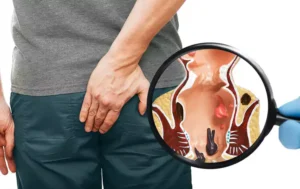Piles

Ayurveda, the ancient Indian system of medicine, offers a unique perspective on health and wellness. In this article, we delve into the Ayurvedic perception of piles, exploring the principles that guide diagnosis, treatment, and prevention.
Introduction
Piles, also referred to as hemorrhoids, is a medical condition affecting the anorectal region. It occurs when the tissues and veins in this area become swollen. Continuous irritation to the anus weakens it, leading to swelling of surrounding tissues and enlargement of veins. Over time, this condition progresses, causing increasing pain. The term “hemorrhoids” is used because these swollen blood vessels may bleed during bowel movements.
Understanding Piles in Ayurveda
In Ayurveda, Piles is referred to as Arsh. Ayurvedic medicine recognizes two primary types of piles, each with several subtypes. The classification in Ayurveda takes into account various factors, including the predominant dosha (Vata, Pitta, or Kapha) involved, the nature of the condition, and its manifestation.
A. Causes of Piles According to Ayurveda.
- Vata Imbalance: Ayurveda attributes piles to an imbalance in the Vata dosha, leading to dryness and hardness in the anal area. Frequent exposure to cold water can increase Vata dosha imbalance.
- Poor Digestive Fire (Agni): Weak digestion, resulting in incomplete digestion of food, is considered a contributing factor in Ayurveda.
- Unhealthy Diet: Consuming spicy, dry, and processed foods, as well as a lack of dietary fiber, can contribute to the development of piles.
- Suppression of Natural Urges: Ignoring or suppressing the urge for bowel movements, urination, or passing gas is believed to disturb the natural flow of Vata and contribute to piles.
- Sedentary Lifestyle: Lack of physical activity and prolonged sitting can lead to stagnation and impairment of blood circulation in the pelvic region, increasing the risk of piles.
- Liver Disorders: Dysfunction in the liver, as per Ayurvedic principles, can impact digestion and contribute to the development of piles.
- Excessive Strain: Activities causing excessive pressure on the anal region, such as heavy lifting or straining during bowel movements, can be a causative factor.
B. Symptoms of Piles in Ayurveda
I. Early signs (Warning Signs)
Prodromal signs of piles are early indicators that precede the onset of the condition. These may include:
- Indigestion: Difficulty in digesting food.
- Fatigue: Persistent tiredness or lack of energy.
- Reduced Weight: Unexplained weight loss.
- Excessive Burps/Flatulence: Increased belching or gas production.
- Pain in Abdomen: Discomfort or pain in the abdominal region.
- Reduced Excretion of Stool: Changes in bowel habits, including reduced stool passage.
- Cramps in Leg: Muscle cramps, particularly in the legs.
- Sourness in Throat: A sensation of sourness or discomfort in the throat.
- Headache: Persistent or recurrent headaches.
- Increased Urination: More frequent urination than usual.
- Thirst: Unusual or excessive thirst.
II. signs and symptoms of piles
- Enlarged, Hard, Painful Lump around Anus: Swollen tissues or veins causing a lump that is firm and painful.
- Discomfort: General unease or irritation in the anal region.
- Bleeding During Excretion: Presence of blood during bowel movements.
- Itchiness around Anus: Persistent itching in the anal area.
- Constipation: Difficulty or infrequency in passing stools.
These manifestations signify the onset of piles, and prompt attention to these symptoms can facilitate early intervention and management of the condition.
C. How Piles Occurs? An Ayurvedic Perspective
In Ayurvedic perception, the occurrence of piles involves a progression of events. The identified causative factors weaken the anus over time. Although the body attempts to repair the anus repeatedly, consistent exposure to these factors exacerbates the damage. Eventually, the anus becomes significantly weakened, and Dosha starts accumulating in the area, causing weakness in the surrounding muscles, fat, and skin. This culmination results in the formation of piles. The continuous irritation further leads to the enlargement of the piles. During the process of excretion, veins near the piles may rupture, leading to bleeding. This Ayurvedic understanding emphasizes the importance of addressing the root causes and preventing the persistent exposure to factors that contribute to the weakening of the anus and the development of piles.
Ayurvedic Diagnosis of Piles
Ayurvedic diagnosis of piles involves a comprehensive approach to assess the individual’s constitution, the nature of the condition, and its underlying causes. Ayurvedic practitioners typically consider factors such as the predominant dosha imbalance (Vata, Pitta, or Kapha), the specific subtype of piles, and the overall state of the patient’s digestive and eliminative functions. Physical examination includes assessing the appearance and characteristics of the piles, as well as the condition of the surrounding tissues. Pulse diagnosis (Nadi Pariksha) and examination of the tongue and eyes are also utilized to gain insights into the individual’s overall health. Ayurvedic diagnosis aims to identify the root causes, the level of dosha involvement, and any associated imbalances in order to tailor a holistic treatment plan. This plan often includes dietary recommendations, lifestyle modifications, herbal formulations, and therapeutic procedures to address the underlying factors and alleviate the symptoms of piles.
Ayurvedic treatment for Piles
A. Herbal Medicines:
Ayurvedic treatment for piles involves the use of herbal medicines that aim to address the root causes, alleviate symptoms, and promote overall well-being. Some commonly used Ayurvedic medicines for piles include:
- Triphala Churna: A blend of three fruits (amla, haritaki, and bibhitaki), Triphala is known for its mild laxative properties, aiding in digestion and promoting bowel regularity.
- Arshoghni Vati: This herbal tablet is specifically designed for hemorrhoids, helping to reduce inflammation, pain, and bleeding associated with piles.
- Abhayarishta: It is a liquid Ayurvedic preparation containing ingredients like haritaki and jaggery, known for their digestive and anti-inflammatory properties.
- Kankayan Vati: This tablet contains ingredients like kankayan, nimbu satva, and yashtimadhu, which are believed to be beneficial in managing piles by reducing swelling and promoting healing.
B. Ayurvedic Therapies:
Ayurvedic therapies for piles focus on holistic approaches to alleviate symptoms, promote healing, and prevent recurrence. Some common Ayurvedic therapies for piles include:
- Sitz Bath (Tubsitz): Soaking the affected area in warm water, often infused with natural ingredients like triphala or neem, helps reduce inflammation, soothe pain, and improve blood circulation in the anal region.
- Kshara Karma: This involves applying a medicated alkaline solution (kshara) directly to the piles, promoting their shrinkage and healing. It is usually performed by trained Ayurvedic practitioners.
- Lepa (Topical Application): External application of herbal pastes or ointments containing ingredients like haritaki, neem, and turmeric can provide relief from pain, itching, and inflammation.
- Basti (Medicated Enema): Introducing medicated oils or decoctions through the rectum helps in balancing the doshas, improving digestion, and reducing inflammation associated with piles.
Preventive Measures for Piles
A. Dietary Guideline
- High-Fiber Foods: Include plenty of fiber-rich foods in your diet, such as whole grains, fruits, vegetables, and legumes. Fiber helps regulate bowel movements and prevents constipation, a common factor in piles.
- Fluid Intake: Drink an adequate amount of water throughout the day to stay hydrated. Water helps soften stools and supports smooth bowel movements.
- Avoid Spicy Foods: Minimize the consumption of spicy and hot foods, as they can aggravate Pitta dosha and contribute to inflammation in the anal region.
- Buttermilk: Include buttermilk in your diet, as it has a cooling effect and can aid digestion. You can also add roasted cumin powder for additional digestive benefits.
- Ghee (Clarified Butter): Use moderate amounts of ghee in your cooking. Ghee is considered soothing for the digestive tract and can help maintain regular bowel movements.
- Papaya: Include ripe papaya in your diet, as it contains enzymes that aid digestion and promote bowel regularity.
- Avoid Dry and Processed Foods: Reduce the intake of dry and processed foods, as they can contribute to dryness in the digestive tract.
- Herbal Teas: Opt for herbal teas like fennel, coriander, or cumin, as they can have a calming effect on the digestive system.
- Limit Caffeine and Alcohol: Reduce or eliminate the consumption of caffeinated beverages and alcohol, as they can contribute to dehydration and may irritate the digestive tract.
- Amla (Indian Gooseberry): Incorporate amla into your diet, as it is rich in vitamin C and has anti-inflammatory properties that can support overall digestive health.
B. Lifestyle Modification
- Regular Bowel Habits: Establish a routine for bowel movements and avoid suppressing the urge. Responding promptly to the natural call of nature helps prevent constipation.
- Physical Activity: Engage in regular physical exercise to promote overall well-being and prevent sedentary habits, which can contribute to poor circulation and piles.
- Avoid Prolonged Sitting or Standing: Take breaks to avoid prolonged periods of sitting or standing, as both can contribute to pressure on the anal region.
- Maintain Hydration: Drink plenty of water throughout the day to stay hydrated. Water helps soften stools and facilitates smoother bowel movements.
- Avoid Straining during Bowel Movements: Straining during bowel movements can exacerbate piles. Ensure a relaxed posture and take your time in the bathroom.
- Mindful Eating: Chew food thoroughly and eat in a calm and relaxed environment. Avoid overeating, and try to follow a regular eating schedule.
- Warm Water Cleansing: After bowel movements, use warm water for cleaning instead of harsh toilet paper. This helps in maintaining hygiene without causing irritation.
C. Yoga for Piles
- Vajrasana (Diamond Pose): This sitting posture helps in improving digestion and reducing the pressure on the rectal region.
- Pavanamuktasana (Wind-Relieving Pose): This asana aids in releasing gas from the digestive tract, promoting better digestion and relieving pressure on the abdomen.
- Malasana (Garland Pose): Malasana can help in preventing and relieving constipation by opening up the pelvic region.
- Baddha Konasana (Butterfly Pose): This pose helps in stretching the inner thighs and can be beneficial for promoting blood circulation in the pelvic area.
- Sarvangasana (Shoulder Stand): Inverted poses like Sarvangasana can improve blood flow to the pelvic region and reduce congestion in the veins.
- Halasana (Plow Pose): This pose helps in reducing pressure on the anal region and improving blood circulation.
- Ardha Matsyendrasana (Half Lord of the Fishes Pose): This seated twist can aid in improving digestion and reducing discomfort in the abdominal area.
- Bhujangasana (Cobra Pose): Bhujangasana strengthens the abdominal muscles and may provide relief from back pain associated with piles.
FAQs
Ayurvedic treatments can be highly effective, especially when tailored to an individual’s doshic constitution and lifestyle.
Ayurveda recommends dietary modifications based on an individual’s dosha, helping to alleviate and prevent piles.
Results vary, but many individuals experience positive changes within a few weeks of following Ayurvedic recommendations.
Ayurveda is not just about treating diseases; it emphasizes maintaining balance for overall physical and mental well-being.
Uniqueness of our therapies
At Arogya Mandir – Shri Siddhanath Ayurvedic Hospital, Miraj, we delve deeply into the ayurvedic examination of each patient. Utilizing noninvasive Ayurvedic diagnostic tools such as Ashtavidha Parikshan and Nadi Parikshan, we precisely determine the pathogenesis of the disease and then prescribe therapies tailored to the specific condition. This approach leads to expedited results.
Our therapies boast the following distinctive features:
– Tranquil and hygienic therapy rooms staffed with trained therapists in a positive environment.
– Selection of appropriate massage oil based on the patient’s Prakruti and the condition of the disease.
– Complimentary Prakruti and Dhatu Sarata examinations before the commencement of therapies.
– Authenticated procedures for each therapy.
– Judicious use of herbal medicines and instruments during the therapy sessions.
– Specialized rooms equipped with all facilities for inpatient care.
Feel free to share this article at no cost.
Copyright message – Dr. Prashant Chivate has published this article on drchivateayurved.org for informational purposes about diseases. Any other use of this article is strictly prohibited. All rights reserved.
